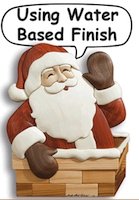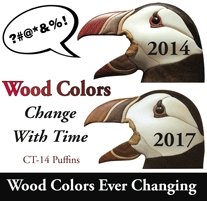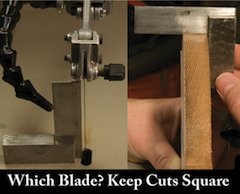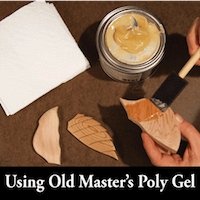Water Based Finish


The aspen on the puffins and the Santa has the water based acrylic finish. Time will tell if the aspen gradually turns more yellow. The aspen has yellowed quite a bit on pieces that are over 10 years old.
Intarsia Whiting Gel is also good if using white pine or any white wood that yellows. The white pigment will help keep the wood a lighter shade. This whiting is the same basic formula as the regular Old Masters clear gel finish, with white pigment added. The pigment can make the gel look more lumpy. For more natural results just use one coat of white followed by two coats of clear. Be sure your wood is nice and smooth, with any stain if there are scratches the white really soaks in and will stand out more.
For all you purists out there, if you do not want to use stains of any kind the “High Performance Polyurethane Water Based Top Coat” is probably your best bet.
 I made the Panda in 2000, so it's been exposed to the light for many years.
I made the Panda in 2000, so it's been exposed to the light for many years.I have a unique opportunity to have most of the pieces created for the patterns hanging in the building. Some are from 1988. I can see how wood colors change over time. Some wood gets lighter and some gets darker. I have found most red colored wood gradually turns brown. I used to use WRC for faces however it gets very dark as it ages. I use Basswood for any people. Yellow heart keeps it's color very well.
3 Responses
Judy
SUE ANN GODDARD
December 19, 2022
I cannot find an “intarsia whiting gel” but I see a “white gel stain.” Is this the same thing? If not, what source do you recommend? Thank you.
Sue, you are correct it is Gel Stain “Pickling White”. I prefer not to use the white because it does have white pigment in it. The edge grain really absorbs the white. When I used white pine for the white wood on projects I would use one coat of the white and two coats of the clear. The pine yellows so quickly the white kept the color better. Now I use aspen and a non yellowing finish, Krylon UV Archival Varnish that doesn’t need sanding between coats. I used 4/0 steel wool between coats, especially on the Aspen. I applied four coats.
Judy
Sue Ann Goddard
I cannot find an “intarsia whiting gel” but I see a “white gel stain.” Is this the same thing? If not, what source do you recommend? Thank you.
Carl Robinson
I use red aromatic cedar for any red sections. With a clear spray poly the color stays very well
Leave a comment
Comments will be approved before showing up.





Judy Roberts
Author